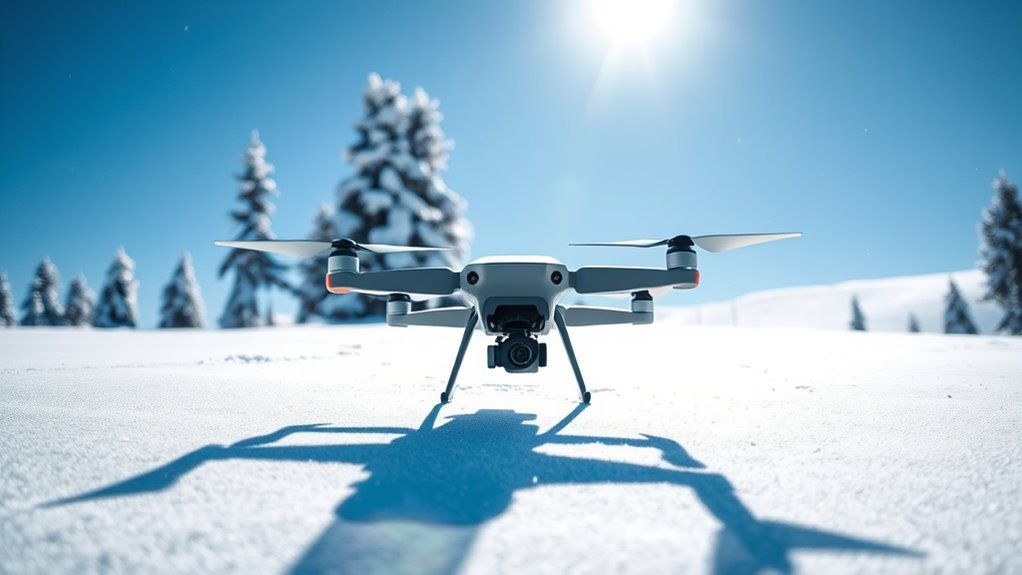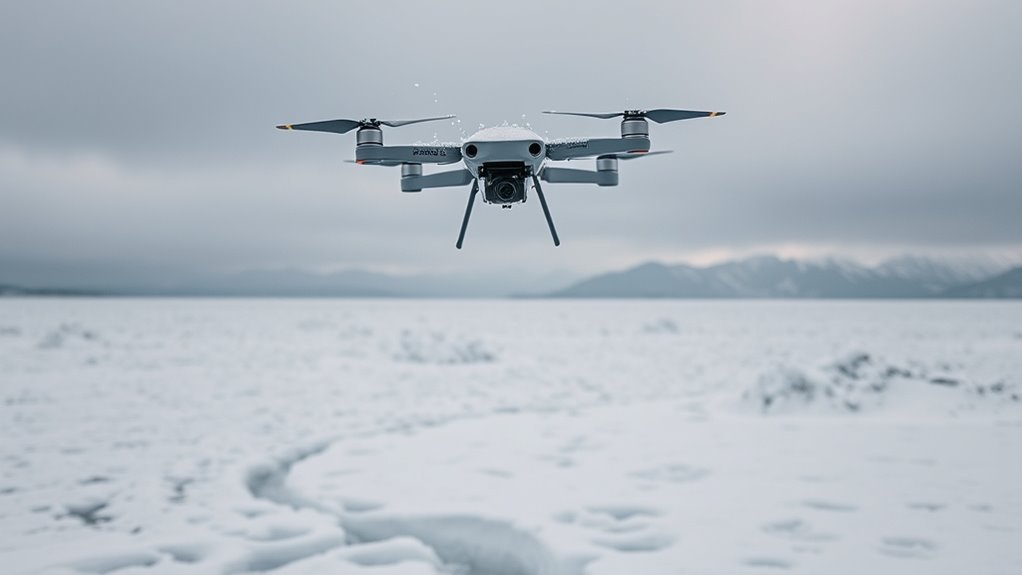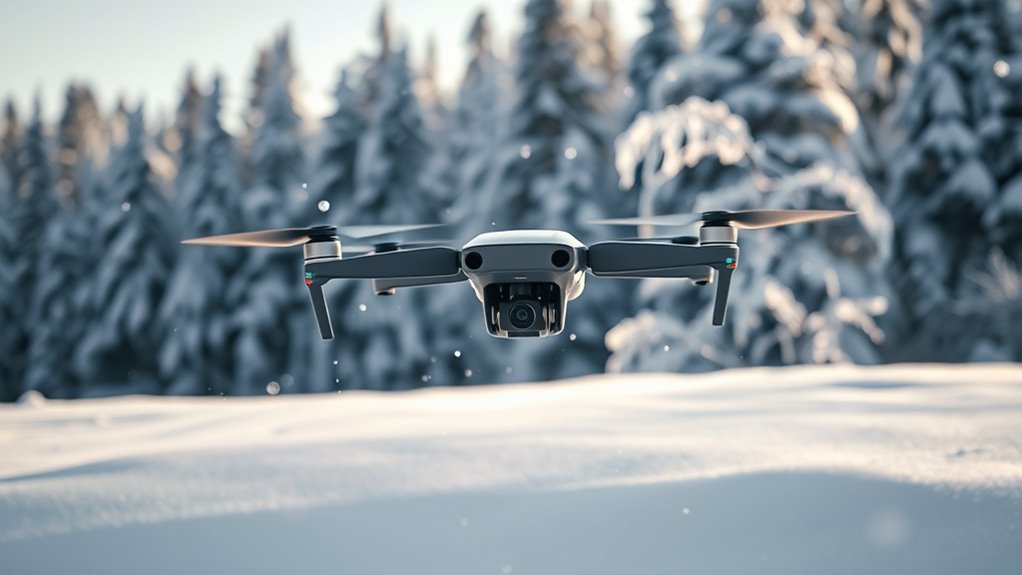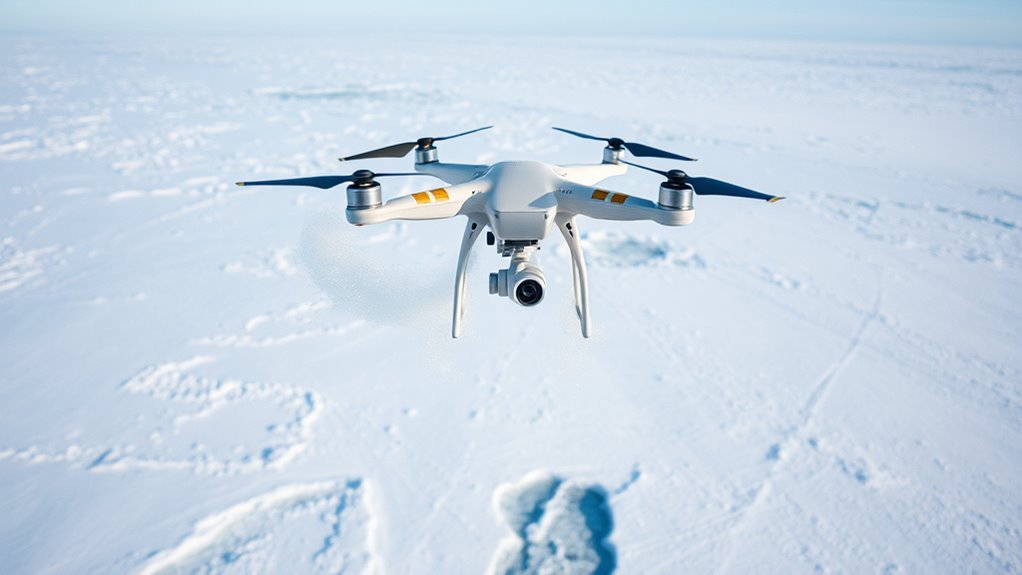When you fly a drone in snow, expect battery performance to drop sharply due to cold-induced chemical slowdowns and increased internal resistance. Visibility gets compromised by falling snow and whiteout conditions, while moisture from snow can infiltrate electronics, risking shorts and corrosion. Snow also disrupts propeller balance and may lead to ice buildup, impairing control and thrust. GPS accuracy declines too, complicating navigation. Understanding these risks helps guarantee safer, more reliable drone operations in snowy environments.
Impact of Cold Temperatures on Battery Life

When you operate a drone in cold temperatures, you’ll notice a significant reduction in battery performance due to the decreased chemical reaction rates within lithium-ion cells. Cold weather slows the electrochemical processes, increasing internal resistance and reducing the effective capacity of the battery. This results in shorter flight times and diminished power output. You must account for this decline to avoid unexpected shutdowns. Additionally, cold temperatures can cause voltage drops that trigger safety cutoffs in the drone’s power management system, further limiting operational time. To maintain peak battery performance, pre-warming batteries before flight and minimizing exposure to low temperatures during storage are essential. Understanding these factors guarantees you preserve your drone’s autonomy and maintain control, enabling you to fly with confidence even in challenging cold weather conditions.
Visibility Challenges in Snowy Conditions

When flying a drone in snowy conditions, you’ll face a considerably reduced line of sight due to falling snow and low contrast environments. Snowfall can obstruct your camera’s view, complicating real-time image processing and sensor accuracy. Consequently, these factors increase navigational difficulty, raising the risk of collision or loss of control.
Reduced Line of Sight
Although snow can create a visually striking environment, it substantially reduces your line of sight when flying a drone. Snowfall and overcast conditions scatter ambient light, lowering contrast and making it difficult to distinguish your drone against a mainly white background. This degradation in drone visibility limits your ability to maintain visual contact, critical for safe operation. Weather conditions like fog or low clouds further compound this issue, reducing the effective range at which you can observe your drone. Without a clear line of sight, you risk losing orientation and control, increasing the likelihood of accidents. To safeguard your freedom to fly, you must assess visibility limitations rigorously and consider supplemental tracking technologies or restricting flights to clearer weather windows where your line of sight remains uncompromised.
Snowfall Obstruction Effects
Because falling snow considerably disrupts visual clarity, it poses a major challenge for drone operators relying on direct line of sight. Snow visibility diminishes rapidly as snowfall density increases, creating a dynamic environment where you must continuously assess visual feedback. This degradation complicates your ability to detect terrain hazards such as trees, power lines, and uneven ground contours. The intermittent nature of snowflakes can cause momentary blind spots, making obstacle avoidance unpredictable. To maintain operational freedom, you need to anticipate how snow visibility fluctuates and adjust altitude and flight paths accordingly. Understanding these obstruction effects is critical to prevent collisions and maintain control. Without precise attention to snowfall conditions, you risk losing situational awareness, which can compromise both your drone’s safety and your ability to navigate complex terrain hazards effectively.
Navigational Difficulty Increase
As snow accumulates, your ability to navigate a drone becomes increasingly compromised due to reduced visibility and impaired sensor performance. Snow navigation demands heightened attention to drone tracking systems, which may struggle to maintain accuracy in low-contrast environments. You’ll face these challenges:
- Visual obscuration from dense snowfall limits line-of-sight control
- GPS signals can degrade from atmospheric interference caused by snow
- Optical sensors and cameras may malfunction or deliver unreliable data
- Automated obstacle avoidance systems may fail to detect snow-covered hazards
- Increased latency in telemetry data can cause delayed responses
Understanding these factors lets you maintain control and freedom while minimizing risk. Adapting your flight plan and relying on redundant navigation aids is essential to overcome snow-induced navigational difficulty increases.
Moisture and Snow Ingress Risks

When operating a drone in snowy conditions, you must consider the risk of moisture and snow ingress, which can compromise internal electronics and sensors. Snow landing or accumulation on your drone can begin to melt due to internal heat or external temperature fluctuations, leading to moisture absorption by vulnerable components. This moisture can cause short circuits, corrosion, or sensor malfunction, directly affecting flight stability and control. Even small amounts of water entering seams or ventilation points may degrade performance or cause permanent damage. To maintain operational freedom, you need to guarantee your drone has adequate sealing and consider protective coatings or enclosures. Understanding how moisture interacts with your drone’s materials and electronics is vital to preventing failures during snow flights and preserving your ability to explore without interruption.
Reduced GPS and Signal Reliability
Although drones rely heavily on GPS for navigation, snowy conditions can greatly reduce signal reliability and accuracy. When you fly in snow, GPS interference and signal attenuation become significant challenges, limiting your drone’s ability to maintain precise positioning. You might experience:
- Increased signal attenuation due to dense snowflakes scattering GPS signals
- Temporary GPS interference from atmospheric moisture variations
- Reduced satellite visibility as snow clouds obstruct line-of-sight
- Intermittent loss of control or delayed response times
- Difficulty in returning-to-home functions relying on accurate GPS data
Understanding these technical limitations is vital. You want the freedom to explore, but snow-induced GPS and signal degradation demand extra caution to avoid disorientation or loss of control during flight.
Effects of Snow on Propeller Performance
When you fly a drone in snowy conditions, snow accumulation on the propellers can disrupt aerodynamic balance, reducing thrust efficiency. Ice formation poses additional risks by increasing weight and altering blade shape, which compromises stability. Understanding these effects is essential for maintaining optimal performance and flight safety.
Snow Accumulation Impact
Because snow can quickly accumulate on drone propellers, you’ll notice a significant decline in their aerodynamic efficiency. This accumulation disrupts the smooth airflow essential for ideal drone performance, especially under varying snow conditions. You’ll face:
- Increased drag leading to reduced thrust
- Imbalanced propeller weight causing vibrations
- Higher motor load, risking overheating
- Decreased flight stability and control responsiveness
- Shortened battery life due to extra power demand
These factors collectively impair your drone’s ability to maintain steady flight, limiting maneuverability and increasing the risk of abrupt power loss. To preserve freedom in snowy environments, monitor propeller conditions closely and clear snow buildup promptly. Understanding how snow accumulation impacts your drone’s mechanics helps you adapt strategies for safer, more efficient flying in harsh winter conditions.
Ice Formation Risks
Beyond the immediate effects of snow accumulation on your drone’s propellers, ice formation presents a more insidious threat to performance. Ice accumulation alters the aerodynamic profile of each blade, disrupting airflow and increasing drag. This imbalance leads to vibrations that can stress your drone’s motors and frame, compromising flight stability. You need to recognize that even thin layers of ice can greatly degrade propeller efficiency, making precise control difficult. Regular drone maintenance becomes essential to detect and remove ice buildup before it impairs flight. Employing pre-flight inspections and post-flight cleaning routines helps mitigate these risks. Understanding how ice forms and affects propeller dynamics empowers you to maintain operational freedom, ensuring your drone performs ideally in snowy environments without unexpected mechanical failures.
Reduced Thrust Efficiency
Although snow accumulation may seem minor, it considerably reduces your drone’s propeller thrust efficiency by altering blade aerodynamics. This thrust reduction directly impacts drone performance, limiting maneuverability and flight time. Snow adheres to propeller surfaces, disrupting smooth airflow and increasing drag. You’ll notice decreased lift generation and increased power consumption, forcing your motors to work harder. Key effects include:
- Altered blade shape reduces aerodynamic efficiency
- Increased weight from snow adds to thrust demand
- Surface roughness causes turbulent airflow, lowering thrust
- Motor strain escalates due to compensating for lost lift
- Battery drains faster, shortening operational freedom
Understanding these factors helps you anticipate performance degradation and avoid unexpected flight limitations in snowy conditions.
Risk of Drone Icing and Mechanical Issues
When operating a drone in snowy conditions, you’ll need to contemplate the risk of ice accumulation on critical components such as propellers and sensors. Ice buildup can disrupt aerodynamic balance, reduce sensor accuracy, and increase mechanical strain, potentially leading to system failures. To mitigate these risks, rigorous drone maintenance before and after flights is vital. Inspect moving parts for ice deposits and guarantee lubrication isn’t compromised by moisture. Implement icing prevention strategies like utilizing heated components or selecting flights during milder snowfall. Ignoring these precautions not only compromises flight stability but also shortens your drone’s operational lifespan. By addressing icing risks methodically, you maintain control and extend your drone’s reliability, allowing you to enjoy the freedom of flight even in challenging snowy environments.
Navigation Difficulties in Snow-Covered Landscapes
Mechanical reliability is only part of the challenge flying a drone in snowy conditions presents. Snow navigation demands acute landscape awareness because snow-covered terrain obscures visual landmarks critical for orientation. You’ll face reduced GPS accuracy as snow reflection interferes with satellite signals, complicating autonomous flight modes. Whiteout conditions can confuse optical sensors, leading to navigation errors. To maintain control and freedom in flight, consider these factors:
- Limited contrast reduces visual feature recognition
- Snow cover masks obstacles and terrain changes
- Refraction and reflection disrupt GPS signals
- Optical flow sensors may misinterpret uniform surfaces
- Rapid weather changes alter landscape appearance
Mastering snow navigation requires adapting to these constraints to guarantee precise positioning and safe operation.
Safety Precautions for Snow Drone Flights
Since snow conditions introduce unique challenges to drone operation, you’ll need to implement specific safety precautions to mitigate risks. Start with a rigorous pre flight checklist that includes verifying battery temperature and charge, inspecting propellers for ice accumulation, and confirming GPS signal strength. Adjust your drone’s calibration to account for magnetic interference common in snowy environments. Establish clear emergency protocols tailored to snow-related contingencies, such as sudden loss of visibility or rapid battery depletion from cold exposure. Always plan for swift retrieval in case of unexpected landings on snow or ice. Maintaining situational awareness and anticipating environmental shifts will maximize your operational freedom while minimizing risks. By adhering strictly to these technical measures, you guarantee safer flights and protect both your drone and your mission objectives in snowy conditions.

